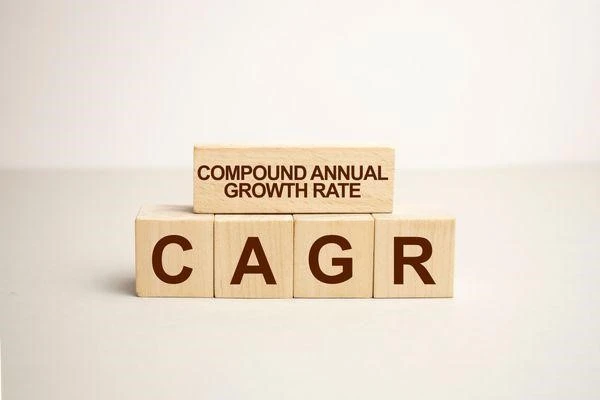When investing in mutual funds, understanding the potential for growth and how to measure it accurately is crucial. One of the most widely used metrics to gauge the performance of a mutual fund over a period of time is the Compound Annual Growth Rate (CAGR). It’s a powerful tool that helps investors understand how their money has grown (or can grow) at a consistent rate, making it easier to compare different funds or investment options.
In this article, we will break down the concept of CAGR and explore how it applies to mutual funds.
What is CAGR?
Compound Annual Growth Rate (CAGR) is a measure of the mean annual growth rate of an investment over a specified time period, assuming the profits were reinvested. It shows the rate at which an investment would have grown if it had experienced steady growth year after year.
Unlike simple returns, which can fluctuate widely year-to-year, CAGR smoothens the growth over a specific period, giving a clearer picture of the investment’s performance.
CAGR Formula
The formula to calculate CAGR is:

Where:
- Ending Value: The value of the mutual fund investment at the end of the period.
- Beginning Value: The initial value of the mutual fund investment at the start.
- n: The number of years over which the growth is measured.
CAGR is essentially the “smoothed” annual return rate over the given period, eliminating any extreme fluctuations from individual years.
Why is CAGR Important in Mutual Funds?
1. Consistency of Returns
Mutual funds can experience significant ups and downs over short periods due to market volatility. CAGR gives a better understanding of the long-term performance, ignoring short-term volatility and providing a more stable view of growth.
2. Comparing Mutual Funds
With thousands of mutual funds available, comparing performance can be overwhelming. CAGR simplifies this by calculating the annualized growth of the fund over a chosen time frame, making it easier to compare different funds.
3. Simplifies Financial Planning
Since mutual funds are often part of long-term investment strategies, such as retirement savings, understanding CAGR can help investors forecast future returns based on past performance.
How to Calculate CAGR for a Mutual Fund
Let’s go through a practical example. Suppose you invest $10,000 in a mutual fund, and after 5 years, the investment grows to $18,000. Using the CAGR formula:
In this case, the mutual fund has grown at an average rate of 12.47% annually over the five-year period. Even if some years saw better or worse performance than others, the CAGR represents a smoothed rate of return.
Advantages of Using CAGR in Mutual Funds
1. Gives an Accurate View of Long-Term Growth
Rather than being swayed by short-term gains or losses, CAGR offers a clearer picture of how well a mutual fund has performed over a longer period. This helps investors make informed decisions.
2. Ideal for Goal-Based Planning
Investors often set financial goals for the future, like saving for a home or retirement. By understanding the CAGR of their mutual fund investments, they can project how much their investment might grow over time and adjust their contributions accordingly.
3. Useful for Benchmarking
CAGR can be compared to a benchmark index like the S&P 500 or a mutual fund’s specific benchmark. If the mutual fund’s CAGR outpaces its benchmark over time, it indicates better-than-average performance.
Limitations of CAGR in Mutual Funds
While CAGR is a useful metric, it does have limitations:
1. Does Not Show Volatility
CAGR assumes a steady growth rate, which may not reflect the actual ups and downs of the mutual fund. For instance, a mutual fund could have experienced years of significant losses or gains, but CAGR smooths these fluctuations, hiding volatility.
2. Past Performance is Not a Guarantee of Future Returns
While CAGR gives a good indication of past growth, it does not guarantee that the fund will continue to perform the same way in the future.
3. Ignores Dividends and Interim Returns
CAGR is based on the beginning and ending values of the investment. It does not consider the interim returns or dividends that may have been paid out during the period unless they are reinvested.
Comparing Mutual Funds with CAGR
Let’s say you are comparing two mutual funds. Mutual Fund A has grown from $10,000 to $15,000 in 3 years, and Mutual Fund B has grown from $10,000 to $18,000 in the same period. To compare the performance of both funds, you can calculate the CAGR for each:
- For Mutual Fund A:

- For Mutual Fund B:
While both funds grew in value, Mutual Fund B had a higher CAGR, meaning it provided a better annualized return over the 3-year period.
Conclusion
Understanding CAGR in the context of mutual funds is essential for investors aiming to evaluate their investments effectively. CAGR provides a clear, concise, and consistent way to measure and compare the growth of mutual funds over time. By smoothing out short-term fluctuations and showing the average growth per year, it allows investors to see the bigger picture of their mutual fund’s performance.
However, investors should also be aware of the limitations of CAGR and use it alongside other metrics—such as volatility, risk-adjusted returns, and historical performance to make well-rounded investment decisions.
FAQs about CAGR in Mutual Funds
1. How often should I use CAGR to evaluate my mutual fund?
It’s a good idea to calculate CAGR over multiple time frames (e.g., 3 years, 5 years, 10 years) to see how consistent the fund’s performance has been over different periods.
2. Is a higher CAGR always better?
Not necessarily. A higher CAGR is good, but you should also consider factors like risk, volatility, and whether the mutual fund aligns with your investment goals.
3. What is the difference between CAGR and absolute return?
Absolute return measures the total percentage change in value from the beginning to the end, while CAGR gives the average annual growth rate, smoothing out any volatility.
By using CAGR wisely, you can enhance your investment strategy and make more informed decisions about which mutual funds to invest in for long-term growth.

